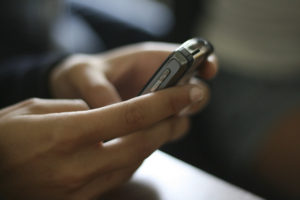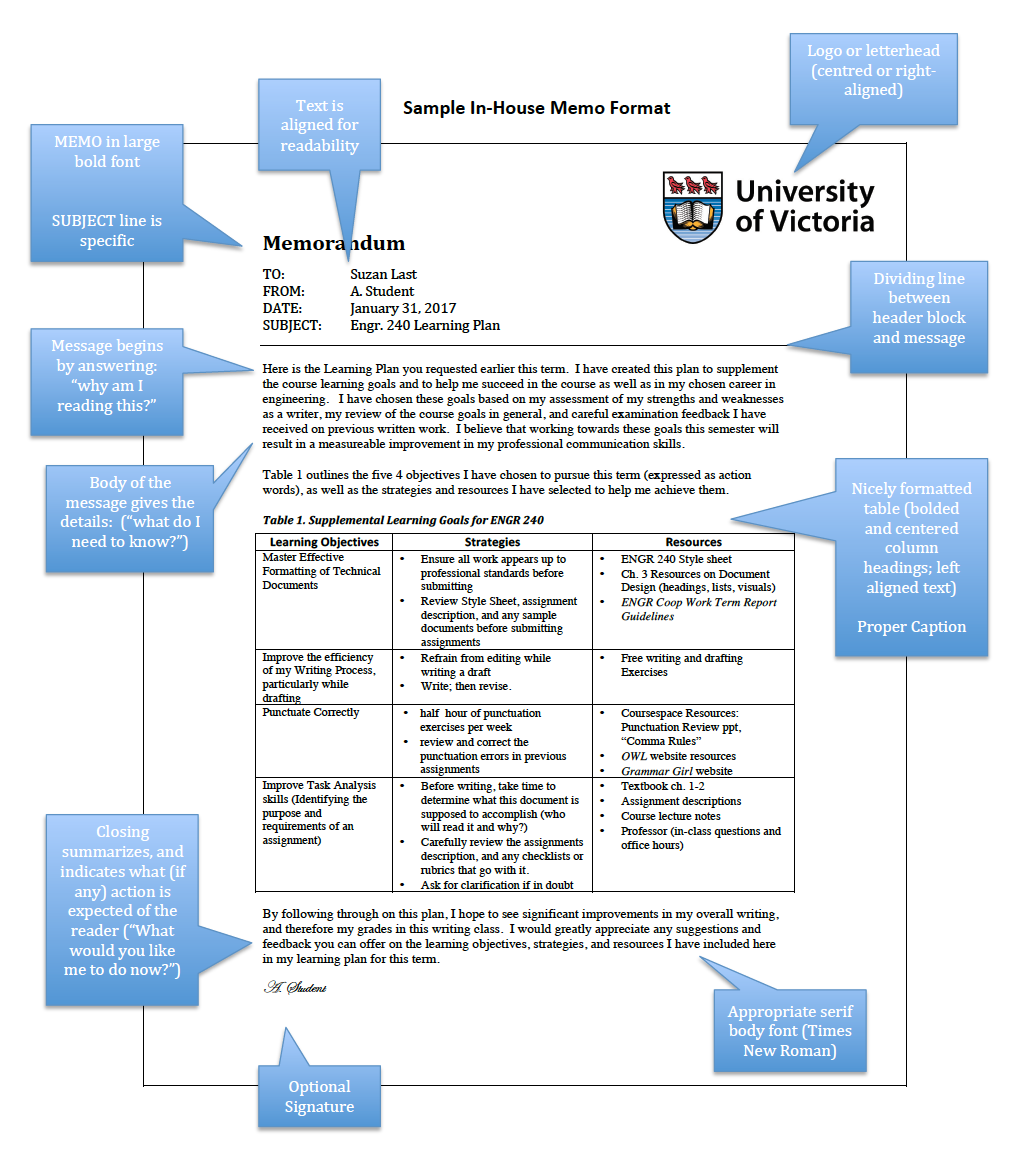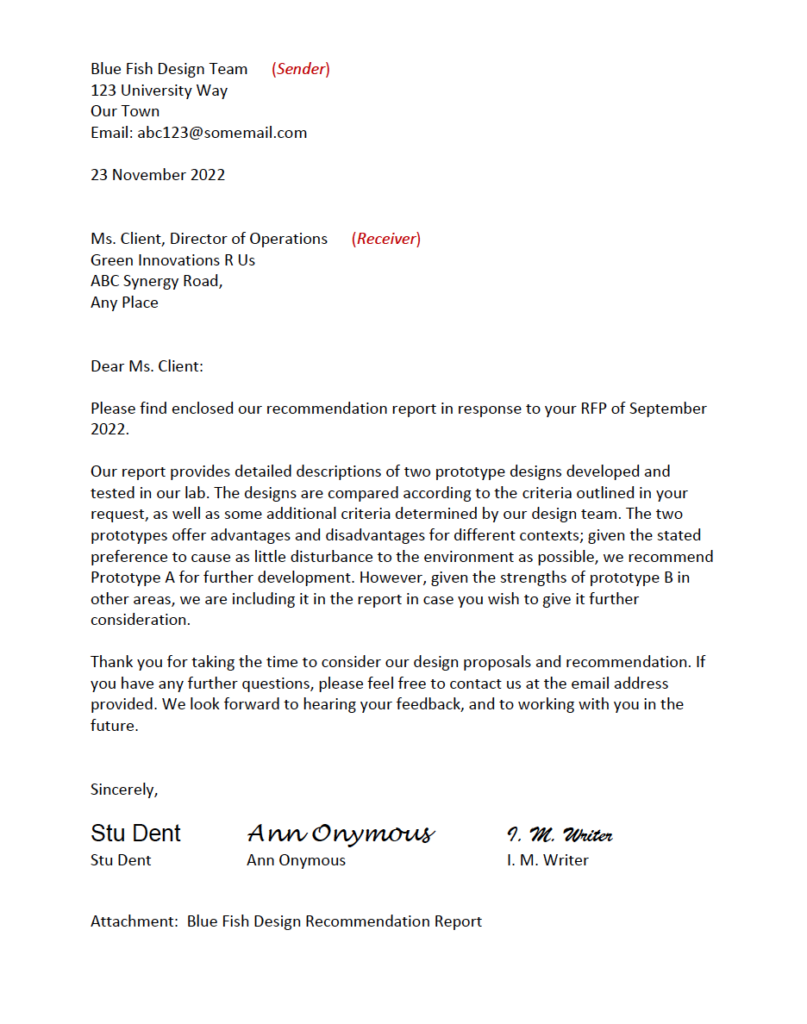7. COMMON DOCUMENT TYPES
7.1 Correspondence: Text Messages, Emails, Memos, and Letters
Netiquette
Text messaging, emailing, and posting on social media in a professional context requires that you be familiar with “netiquette,” or proper etiquette for using the internet. We have all heard the news stories about people who have been fired and companies that have been boycotted for making offensive or inappropriate social media posts. People have even gone to prison for illegal use of private messaging. The digital world may seem like a free-for-all, “wild wild west” with no clear rules or regulations; however, this is clearly a dangerous perspective for a professional to take, as the consequences for breaking tacit rules, expectations, and guidelines for professional communications can be very costly.
The way that you represent yourself in writing carries significant weight. Writing in an online environment requires tact, skill, and an awareness that what you write may be there for a very long time and may be seen by people you never considered as your intended audience. From text messages to memos to letters, from business proposals to press releases, your written business communication represents you and your company: your goal is to make it clear, concise, constructive, and professional.
We create personal pages, post messages, and interact via online technologies as a normal part of our careers, but how we conduct ourselves can leave a lasting image, literally. The photograph you posted on your Instagram page may have been seen by your potential employer, or that insensitive remark in a Facebook post may come back to haunt you later.
Following several guidelines for online postings, as detailed below, can help you avoid embarrassment later:
- Know your context
- Avoid assumptions about your readers; remember that culture influences communication style and practices
- Familiarize yourself with policies on Acceptable Use of IT Resources at your organization.
- Remember the human
- Remember there is a person behind the words; ask for clarification before making judgment
- Check your tone before you publish; avoid jokes, sarcasm, and irony as these can often be misinterpreted and get “lost in translation” in the online environment
- Respond to people using their names
- Remember that culture, age, and gender can play a part in how people communicate
- Remain authentic and expect the same of others
- Remember that people may not reply immediately. People participate in different ways, some just by reading the communication rather than jumping into it.
- Recognize that text is permanent
- Be judicious and diplomatic; what you say online may be difficult or even impossible to retract later.
- Consider your responsibility to the group and to the working environment
- Agree on ground rules for text communication (formal or informal; seek clarification whenever needed) if you are working collaboratively
- Avoid flaming: research before you react
- Accept and forgive mistakes
- Consider your responsibility to the group and to the working environment
- Seek clarification before reacting; what you heard is not always what was said
- Ask your supervisor for guidance.*
- Respect privacy and original ideas
- Quote the original author if you are responding with a specific point made by someone else
- Ask the author of an email for permission before forwarding the communication.
* Sometimes, online behaviour can appear so disrespectful and even hostile that it requires attention and follow up. In this case, let your supervisor know right away so that the right resources can be called upon to help.
For further information on netiquette, check out the following links:
- Business Insider: Email etiquette rules every professional needs to know
- LinkedIn: Email etiquette: Setting the tone for your professional communication
Texting

Whatever digital device you use, written communication in the form of brief messages, or texting, has become a common way to connect. It is useful for short exchanges, and is a convenient way to stay connected with others when talking on the phone would be cumbersome. Texting is not useful for long or complicated messages, and careful consideration should be given to the audience.
When texting, always consider your audience and your company, and choose words, terms, or abbreviations that will deliver your message appropriately and effectively.
If your work situation allows or requires you to communicate via text messages, keep the following tips in mind:
- Know your recipient: “? % dsct” may be an understandable way to ask a close associate what the proper discount is to offer a certain customer, but if you are writing a text to your boss, it might be wiser to write, “what % discount does Murray get on $1K order?”
- Anticipate unintentional misinterpretation: texting often uses symbols and codes to represent thoughts, ideas, and emotions. Given the complexity of communication, and the useful but limited tool of texting, be aware of its limitation and prevent misinterpretation with brief messages.
- Use appropriately: contacting someone too frequently can border on harassment. Texting is a tool. Use it when appropriate but don’t abuse it.
- Don’t text and drive: research shows that the likelihood of an accident increases dramatically if the driver is texting behind the wheel.[2] Being in an accident while conducting company business would reflect poorly on your judgment as well as on your employer.

Email is familiar to most students and workers. In business, it has largely replaced print hard copy letters for external (outside the company) correspondence, and in many cases, it has taken the place of memos for internal (within the company) communication.[4]
Email can be very useful for messages that have slightly more content than a text message, but it is still best used for fairly brief messages. Many businesses use automated emails to acknowledge communications from the public, or to remind associates that periodic reports or payments are due. You may also be assigned to “populate” a form email in which standard paragraphs are used but you choose from a menu of sentences to make the wording suitable for a particular transaction.
Emails may be informal in personal contexts, but business communication requires attention to detail, awareness that your email reflects you and your company, and a professional tone so that it may be forwarded to any third party if needed. Email often serves to exchange information within organizations. Although email may have an informal feel, remember that when used for business, it needs to convey professionalism and respect. Never write or send anything that you wouldn’t want read in public or in front of your company president.
As with all writing, professional communications require attention to the specific writing context, and it may surprise you that even elements of form can indicate a writer’s strong understanding of audience and purpose. The principles explained here apply to the educational context as well; use them when communicating with your instructors and classroom peers.
Open with a proper salutation: proper salutations demonstrate respect and avoid mix-ups in case a message is accidentally sent to the wrong recipient. For example, use a salutation like “Dear Ms. X” (external) or “Hi Barry” (internal).
Include a clear, brief, and specific subject line: this helps the recipient understand the essence of the message. For example, “Proposal attached” or “Electrical specs for project Y.”
Close with a signature: identify yourself by creating a signature block that automatically contains your name and business contact information.
Avoid abbreviations: an email is not a text message, and the audience may not find your wit cause to ROTFLOL (roll on the floor laughing out loud).
Be brief: omit unnecessary words.
Use a good format: divide your message into brief paragraphs for ease of reading. A good email should get to the point and conclude in three small paragraphs or fewer.
Reread, revise, and review: catch and correct spelling and grammar mistakes before you press “send.” It will take more time and effort to undo the problems caused by a hasty, poorly-written email than to take the time to get it right the first time.
Reply promptly: watch out for an emotional response—never reply in anger—but make a habit of replying to all emails within twenty-four hours, even if only to say that you will provide the requested information in forty-eight or seventy-two hours.
Use “Reply All” sparingly: do not send your reply to everyone who received the initial email unless your message absolutely needs to be read by the entire group.
Avoid using all caps: capital letters are used on the Internet to communicate emphatic emotion or “yelling” and can be considered rude.
Test links: if you include a link, test it to make sure it works.
Email ahead of time if you are going to attach large files: audio and visual files are often quite large; be careful to avoid exceeding the recipient’s mailbox limit or triggering the spam filter.
Give feedback or follow up: if you don’t get a response in twenty-four hours, email or call. Spam filters may have intercepted your message, so your recipient may never have received it.
Tip: add the address of the recipient last (after you have written and proofread your message) to avoid sending prematurely. This will give you time to do a last review of what you’ve written, make sure links work, make sure you’ve added the attachment, etc., before adding the sender’s address and hitting send.
The sample email below demonstrates the principles listed above.
From: Steve Jobs <sjobs@apple.com>
To: Human Resources Division <hr@apple.com>
Date: September 12, 2015
Subject: Safe Zone Training
Dear Colleagues:
Please consider signing up for the next available Safe Zone workshop offered by the College. As you know, our department is working toward increasing the number of Safe Zone volunteers in our area, and I hope several of you may be available for the next workshop scheduled for Friday, October 9.
For more information on the Safe Zone program, please visit http://www.cocc.edu/multicultural/safe-zone-training/
Please let me know if you will attend.
Steve Jobs
CEO Apple Computing
sjobs@apple.com
Memos
Memoranda, or memos, are one of the most versatile document forms used in professional settings. Memos are “in house” documents (sent within an organization) to pass along or request information, outline policies, present short reports, and propose ideas. While they are often used to inform, they can also be persuasive documents. A company or institution typically has its own “in house” style or template that is used for documents such as letters and memos.
Memo Format
Figure 7.1.1 shows a sample of one particular “in house” memo style (the style we might use for memo assignments written for this class), with annotations pointing out various relevant features. Note that “in house” formats may vary. The main formatted portions of a memo are the Logo or Letterhead (optional), the Header Block, and the Message. The attached Memos PowerPoint reviews some of these features in detail.

Memo Header Block
The Header Block appears at the top left side of your memo, directly underneath the word MEMO or MEMORANDUM in large, bold, capitalized letters. This section contains detailed information on the recipient, sender, and purpose. It includes the following lines:
- TO: give the recipient’s full name, and position or title within the organization
- FROM: include the sender’s (your) full name and position or title
- DATE: include the full date on which you sent the memo
- SUBJECT or RE: write a brief phrase that concisely describes the main content of your memo.
Place a horizontal line under your header block, and place your message below.
Memo Message
The length of a memo can range from a few short sentences to a multi-page report that includes figures, tables, and appendices. Whatever the length, there is a straightforward organizational principal you should follow. Organize the content of your memo so that it answers the following questions for the reader:
- Opening: Why am I reading this?
- Details: What do I need to know?
- Closing: What am I expected to do now?
Memos are generally very direct and concise. There is no need to start with general introductions before getting to your point. Your readers are colleagues within the same organization, and are likely familiar with the context in which you are writing. The opening sentences of the memo’s message should make it clear to the reader whether they have to read this entire memo and why (if the memo is informing me about an elevator that’s out of service in a building I never enter, then I don’t really have to read any further).
The middle section of the message should give all of the information needed to adequately inform the readers and fulfill the purpose of the memo. Start with the most general information, and then add the more specific facts and details. Make sure there is enough detail to support your purpose, but don’t overwhelm your readers with unnecessary details or information that is already well known to them.
The final part of the message indicates what, if any, action is required or requested of the readers. If you are asking your readers to do something, be as courteous as possible, and try to indicate how this action will also benefit them.
For more information on writing memos, check out the memo page on the the Online Writing Lab at Purdue University: Parts of a Memo.
Letters
Letters are brief messages sent to recipients that are often outside the organization. They are often printed on letterhead paper that represents the business or organization, and are generally limited to one or two pages. While email and text messages may be used more frequently today, the business letter remains a common form of written communication. It can serve to introduce you to a potential employer, announce a product or service, or even serve to communicate feelings and emotions (compliant letters, for example).
There are many types of letters, and many adaptations in terms of form and content, but this chapter presents the 7 key elements of a traditional block-style letter. Letters may serve to introduce your skills and qualifications to prospective employers (cover letter), deliver important or specific information, provide documentation of an event or decision, or introduce an attached report or long document (letter of transmittal). Figure 7.1.2 shows a letter of transmittal meant to introduce a technical report to its recipient. Here is a downloadable pdf version: Sample Letter of Transmittal of the image below.

A typical letter has 7 main parts:
- Letterhead/logo: Sender’s name and return address
- The heading: names the recipient, often including address and date
- Salutation: “Dear ______ ” use the recipient’s name, if known.
- The introduction: establishes the overall purpose of the letter
- The body: articulates the details of the message
- The conclusion: restates the main point and may include a call to action
- The signature line: sometimes includes the contact information
Keep in mind that letters represent you and your company in your absence. In order to communicate effectively and project a positive image, remember that
- your language should be clear, concise, specific, and respectful
- each word should contribute to your purpose
- each paragraph should focus on one idea
- the parts of the letter should form a complete message
- the letter should be free of errors.
Letters with Specific Purposes
There are many possible reasons you might write a letter in a professional context. Here is a list of the most common kinds of letters:
Transmittal Letters: when you send a report or some other document, such as a resumé, to an external audience, send it with a cover letter that briefly explains the purpose of the enclosed document and a brief summary. Click the link to download a Letter of Transmittal Template (.docx).
Letters of Inquiry: you may want to request information about a company or organization such as whether they anticipate job openings in the near future or whether they fund grant proposals from non-profit groups. In this case, you would send a letter of inquiry, asking for additional information. As with most business letters, keep your request brief, introducing yourself in the opening paragraph and then clearly stating your purpose and/or request in the second paragraph. If you need very specific information, consider placing your requests in list form for clarity. Conclude in a friendly way that shows appreciation for the help you will receive.
Follow-up Letters: any time you have made a request of someone, write a follow-up letter expressing your appreciation for the time your letter-recipient has taken to respond to your needs or consider your job application. If you have had a job interview, the follow-up letter thanking the interviewer for his/her time is especially important for demonstrating your professionalism and attention to detail.
Letters within the professional context may take on many other purposes, such as communicating with suppliers, contractors, partner organizations, clients, government agencies, and so on. For additional examples of professional letters, take a look at the sample letters provided by David McMurrey in his online textbook on technical writing: Online Technical Writing: Examples, Cases & Models.
Information in this chapter was adapted from the following source:
“Professional Communications” chapter in Technical Writing by Annemarie Hamlin, Chris Rubio, Michele DeSilva. This source is licensed under a Creative Commons Attribution-ShareAlike 4.0 International License.
Image descriptions
Figure 7.1.1 image description:
Design features of a 1-page memorandum.
- The logo or letterhead is at the top of the page and centred or right-aligned (in this case, it is the University of Victoria letterhead).
- “Memorandum” appears at the top of the page left-aligned in large, bold font.
- The header block (which appears under the “Memorandum” heading) includes a “to,” “from,” “date,” and “subject” in a vertical list. Those values are aligned vertically for readability.
- A dividing line separates the header block from the message.
- The message begins by answering, “Why am I reading this?”
- The body of the message gives the details: (“What do I need to know?”)
- There is a table that is nicely formatted. (The table has a caption above the table in bold and italics, column headers are bold and centred, and text is left aligned.)
- A closing paragraph summarizes and indicates what (if any) action is expected of the reader (Answering, “What would you like me to do now?”)
- The text of this document uses an appropriate serif body font (Times New Roman)
- There is also a signature (optional)
- [Texting image]. [Online]. Available: https://www.flickr.com/photos/13604571@N02/2094946972. CC BY-NC 2.0. ↵
- "Deadly distraction: Texting while driving, twice as risky as drunk driving, should be banned," Houston Chronicle, Sept 23, 2009 [Online]. Available: http://www.chron.com/opinion/editorials/article/Deadly-distraction-Texting-while-driving-should-1592397.php↵ ↵
- [Email icon]. [Online]. Available: https://www.iconfinder.com/icons/4417125/%40_email_envelope_letter_icon. Free for commercial use. ↵
- M. Guffey, Essentials of Business Communication (7th ed.). Mason, OH: Thomson/Wadsworth, 2008. ↵

